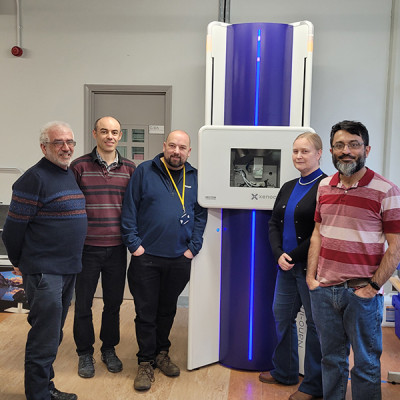News
Queen Mary scientists welcome new equipment in a major boost for materials analysis
11 March 2024


The Faculty of Science at Queen Mary University has acquired a new system allowing us to characterise advanced materials to a new level of detail. The installation of a new X-ray scattering system will enable teams from across the sciences to take these measurements in-house for the first time, instead of relying on an external lab.
The Xenocs Nano-inXider SAXS/WAXD system is located at the interdisciplinary X-ray Diffraction Facility in the Faculty of Science and Engineering, and is capable of simultaneously probing length scales from the atomic (1 Angstrom) to ~1000x larger in the same measurement.
A cross-faculty team from the School of Engineering and Materials Science with the School of Physical and Chemical Sciences worked together on the bid, receiving funding from the Research Capital Infrastructure Fund and the Research Innovation Board.
Potential users of the new equipment span a range of disciplines and applications across the University. From research into new materials for energy and catalysis, pharmaceutical applications, and future manufacturing, to biomimetic and dental materials and mechanobiology.
Small-angle X-ray scattering (SAXS) is a non-destructive technique which can quantify size, shape, orientation, and more complex structures in nanostructured materials. It can be carried out in situ, allowing device and component function to be analysed in realistic engineering conditions. Wide-angle X-ray diffraction (WAXD) enables concurrent molecular structural analysis at the same location.
Dr Richard Whiteley, lead technical officer at the X-ray diffraction facility at QMUL, said “The acquisition of SAXS/WAXD capabilities through the Xenocs Nano-inXider provides a major boost to our portfolio of material analysis techniques, fills a missing gap in quantitative characterisation between the molecular and microscopic scale, and will enhance both our ability to address new scientific questions as well as collaborate with industry and third parties”.
In terms of applications, Prof Alan Drew from the School of Physical and Chemical Sciences at QMUL noted that in energy materials “this system would enable the pores of next generation battery electrodes to be measured, allowing us to close the loop between synthesis parameters, pore sizes and their size distribution, and battery performance. We will also be able to measure the size of inorganic nanoparticles embedded in organic semiconducting devices, which modifies device sensitivity, and so is a critical control parameter”.
In the bioengineering field, his colleague Prof Himadri Gupta from SEMS added “We aim to use the Nano-inXider to detect very small-scale (sub-micron) tissue-level signatures of disease and deterioration in conditions like osteoarthritis or fibrosis (scarring), which are not accessible by other X-ray imaging techniques. Doing so will enable both early detection and development of targeted therapies”.
| Contact: | Himadri Gupta |
| Email: | h.gupta@qmul.ac.uk |
| People: | |
| Research Centre: |

